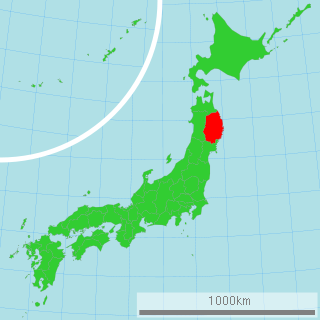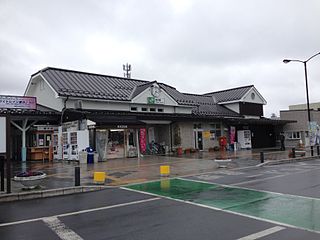| Miyako Bay | |
|---|---|
Miyako Bay | |
| Location | Iwate Prefecture, Japan |
| Coordinates | 39°36′N141°58′E / 39.600°N 141.967°E |
| Ocean/sea sources | Pacific Ocean |
| Basin countries | Japan |
| Max. length | 10 km (6.21 mi) |
| Max. width | 4.8 km (2.98 mi) |
| Surface area | 24 km2 (9.3 sq mi) |
| Average depth | 76 m (249 ft) |
| Settlements | Miyako, Mutsu |
Miyako Bay(宮古湾Miyako-wan) is a bay in Iwate Prefecture, in the northern Tōhoku region of northern Japan. It is a long and narrow, roughly triangular body of water extending southwest to northeast where it opens to the Pacific Ocean. The Omoe Peninsula(重茂半島Omoe-hantō) forms its southern border and Cape Anegasaki(姉ヶ崎Anegasaki) forms its southern border. This gives it an area of approximately 24 km2 (9.3 sq mi). [1]

Iwate Prefecture is a prefecture in the Tōhoku region of Japan. Located on the main island of Honshu, it contains the island's easternmost point. The capital is Morioka. Iwate has the lowest population density of any prefecture outside Hokkaido. Famous attractions include the Buddhist temples of Hiraizumi, including Chūson-ji and Mōtsū-ji with their treasures, Fujiwara no Sato, a movie lot and theme park in Esashi Ward, Oshu City, Tenshochi, a park in Kitakami City known for its big, old cherry trees and Morioka Castle in Morioka City.

The Tōhoku region, Northeast region, or Northeast Japan consists of the northeastern portion of Honshu, the largest island of Japan. This traditional region consists of six prefectures (ken): Akita, Aomori, Fukushima, Iwate, Miyagi, and Yamagata.

Japan is an island country in East Asia. Located in the Pacific Ocean, it lies off the eastern coast of the Asian continent and stretches from the Sea of Okhotsk in the north to the East China Sea and the Philippine Sea in the south.
Miyako Bay is approximately 10 km (6.21 mi) long, with a width of 4.8 km (2.98 mi) at its mouth. The bay has an average depth of 20-40 meters, with a maximum depth of 76 m (249 ft). [1]
Economically, the shallow waters of the bay are an important fishery, with shellfish and seaweed cultivation and aquaculture benefiting from nutrients brought into the almost enclosed waters of the bay the Hei River and the effects of the offshore Kuroshio and Oyashio currents. Tourism is also economically important, as parts of the bay are within the borders of the Sanriku Fukkō National Park, including the scenic Jōdogahama coastline.

Aquaculture, also known as aquafarming, is the farming of fish, crustaceans, molluscs, aquatic plants, algae, and other organisms. Aquaculture involves cultivating freshwater and saltwater populations under controlled conditions, and can be contrasted with commercial fishing, which is the harvesting of wild fish. Mariculture refers to aquaculture practiced in marine environments and in underwater habitats.

Oyashio, also known as Oya Siwo, Okhotsk or the Kurile current, is a cold subarctic ocean current that flows south and circulates counterclockwise in the western North Pacific Ocean. The waters of the Oyashio Current originate in the Arctic Ocean and flow southward via the Bering Sea, passing through the Bering Strait and transporting cold water from the Arctic Sea into the Pacific Ocean and the Sea of Okhotsk. It collides with the Kuroshio Current off the eastern shore of Japan to form the North Pacific Current. The nutrient-rich Oyashio is named for its metaphorical role as the parent that provides for and nurtures marine organisms.

Sanriku Fukkō National Park is a national park extending along the Sanriku Coast of Japan from Hachinohe in Aomori Prefecture through Iwate Prefecture to Kesennuma in Miyagi Prefecture. Created in 2013 in the aftermath of the 2011 Tōhoku earthquake and tsunami, it incorporates the former Rikuchū Kaigan National Park and Tanesashi Kaigan Hashikamidake Prefectural Natural Park. In 2014, the Ministry of the Environment plans to extend the park to include Minami Sanriku Kinkasan Quasi-National Park. Subsequently, the park will be extended to include Kesennuma Prefectural Natural Park, Kenjōsan Mangokuura Prefectural Natural Park, and Matsushima Prefectural Natural Park. At northern part of the national park there is an 8 km long and 200m-high set of cliffs called the Kita Yamazaki; it is said to be Japan's most beautiful coastline.
The Port of Miyako serves as the main seaport for the city of Morioka.






















